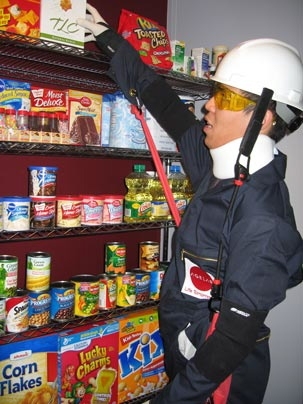The MIT AgeLab was created to creatively translate technologies and insights from behavioral sciences into practical solutions to improve the quality of life of older people and those who care for them. As part of that work, the AgeLab has created the Age Gain Now Empathy System, or AGNES, a suit that when worn mimics the physical restrictions of age. For example, elastic bands, kneepads, wrist guards and a neck collar restrict movement in ways that mirror arthritis and spinal problems. Earplugs reduce hearing, yellow glasses diminish sight, and gloves hinder touch. AGNES' goal, says AgeLab Director Joseph F. Coughlin, age 47, is to help product and system designers, who are often in their 20s and 30s, gain insight into how older people negotiate the world, from kitchen to living and from shopping to cooking. Coughlin recently discussed AGNES and aging issues.
Q. We've been told that 60 is the new 40 and 70 is the new 60, even if all of us eventually age. How will aging differ in the future?
A. Studies indicate cognitive decline may begin by our late 20s, certainly by 30. We know from our own work here on driving that you need twice the light to see at age 40 than you did at age 20. So aging is profoundly younger than people think. Aging is really about your life tomorrow. So how will aging be different in the future? The obvious difference is that, demographically, there are going to be far more older people. But I don't think you can deny, no matter the class, gender or education level, that a 40-, 50- or 60-year-old today is far different than a 40-, 50- or 60-year-old when we were kids. So one of the big changes we see changing is the attitude of what to expect in old age. The baby boomers have moved from the once referred to generation gap in their youth, to an expectations gap in their later years. There will be products and service technologies to facilitate those expectations and to translate them into reality. AGNES will provide the insights to create everyday environments that are youthful, fun, but accessible to all ages.
Q. When did the AgeLab start creating AGNES? Why was it created?
A. AGNES 1.0 was created in 2005. Today we have AGNES 2.0. We put together a multidisciplinary effort that included engineering, medicine, ergonomics and psychology input under the direction of AgeLab colleagues Roz Puleo, an exercise physiologist, and Katie Godfrey, who has a background in psychology. AGNES is a way of getting the designer or engineer to empathize with the consumer. This is not just about what it feels like to be old but it is meant to give insights to designers and engineers as to how to develop what's new. Chances are the lead adopters of new products and services are going to be older than they ever have been before. The adopter of a new iPod might be in his 20s but the lead adopter of the next-generation high-tech, high-style and high-price sedan or home appliance will not be a 20- or 30-year-old.
Q. Recently, representatives from companies as diverse as Siemens, Daimler and General Mills visited the AgeLab, put on the AGNES suit and performed tasks such as using a cell phone, getting in a car, and mixing a batch of cupcakes. What was their reaction?
A. There was a bit of surprise -- is it really this bad? It's interesting most of us can see ourselves one day admitting we'll be dead. None of us can admit that some day we'll be old and losing the full capacity that many of us enjoy everyday. Wearing AGNES gave industry researchers insight into something that reading a study or even a focus group or interview is not going to give you. AgeLab is pioneering innovative methods in user-centered design. AGNES is one part of a growing laboratory knowledgebase of simulation, in-field and laboratory protocols to help everyone at MIT improve the quality of life of older people. After all, aging is not just about the old, it's about all of us.
Q. What's next for AGNES?
A. The next stage is developing more quantitative metrics. It's one thing to "feel their pain," so to speak. It's quite another to be able to start saying to industry, to government and to designers in general, these are the metrics you need to think about as you design our lives tomorrow -- we think aging requires a new box of tools.
Q. Who named AGNES?
A. It was a student and research team collaborative effort powered by pizza.
A version of this article appeared in MIT Tech Talk on April 15, 2009 (download PDF).







